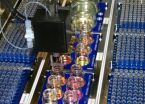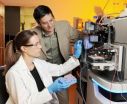(Press-News.org) PASADENA, Calif. -- A team of researchers at the California Institute of Technology (Caltech) has devised a new method for making complex molecules. The reaction they have come up with should enable chemists to synthesize new varieties of a whole subclass of organic compounds called nitrogen-containing heterocycles, thus opening up new avenues for the development of novel pharmaceuticals and natural products ranging from chemotherapeutic compounds to bioactive plant materials such as morphine.
The team—led by Brian Stoltz, the Ethel Wilson Bowles and Robert Bowles Professor of Chemistry, and Doug Behenna, a scientific researcher—used a suite of specialized robotic tools in the Caltech Center for Catalysis and Chemical Synthesis to find the optimal conditions and an appropriate catalyst to drive this particular type of reaction, known as an alkylation, because it adds an alkyl group (a group of carbon and hydrogen atoms) to the compound. The researchers describe the reaction in a recent advance online publication of a paper in Nature Chemistry.
"We think it's going to be a highly enabling reaction, not only for preparing complex natural products, but also for making pharmaceutical substances that include components that were previously very challenging to make," Stoltz says. "This has suddenly made them quite easy to make, and it should allow medicinal chemists to access levels of complexity they couldn't previously access."
The reaction creates compounds called heterocycles, which involve cyclic groups of carbon and nitrogen atoms. Such nitrogen-containing heterocycles are found in many natural products and pharmaceuticals, as well as in many synthetic polymers. In addition, the reaction manages to form carbon-carbon bonds at sites where some of the carbon atoms are essentially hidden, or blocked, by larger nearby components.
"Making carbon-carbon bonds is hard, but that's what we need to make the complicated structures we're after," Stoltz says. "We're taking that up another notch by making carbon-carbon bonds in really challenging scenarios. We're making carbon centers that have four other carbon groups around them, and that's very hard to do."
The vast majority of pharmaceuticals being made today do not include such congested carbon centers, Stoltz says—not so much because they would not be effective compounds, but because they have been so difficult to make. "But now," he says, "we've made it very easy to make those very hindered centers, even in compounds that contain nitrogen. And that should give pharmaceutical companies new possibilities that they previously couldn't consider."
Perhaps the most important feature of the reaction is that it yields almost 100 percent of just one version of its product. This is significant because many organic compounds exist in two distinct versions, or enantiomers, each having the same chemical formula and bond structure as the other, but with functional groups in opposite positions in space, making them mirror images of each other. One version can be thought of as right-handed, the other as left-handed.
The problem is that there is often a lock-and-key interaction between our bodies and the compounds that act upon them—only one of the two possible hands of a compound can "shake hands" and fit appropriately. In fact, one version will often have a beneficial effect on the body while the other will have a completely different and sometimes detrimental effect. Therefore, it is important to be able to selectively produce the compound with the desired handedness. For this reason, the FDA has increasingly required that the molecules in a particular drug be present in just one form.
"So not only are we making tricky carbon-carbon bonds, we're also making them such that the resulting products have a particular, desired handedness," Stoltz says. "This was the culmination of six years of work. There was essentially no way to make these compounds before, so to all of a sudden be able to do it and with perfect selectivity… that's pretty awesome."
INFORMATION:
In addition to Stoltz and Behenna, other authors on the paper, "Enantioselective construction of quaternary N-heterocycles by palladium-catalysed decarboxylative allylic alkylation of lactams," include Yiyang Liu, Jimin Kim, David White, and Scott Virgil of Caltech, and Taiga Yurino, who visited the Stoltz lab on a fellowship supported by the Japan Society for the Promotion of Science. The work was supported by the King Abdullah University of Science and Technology, the NIH-NIGMS, the Gordon and Betty Moore Foundation, Amgen, Abbott, and Boehringer Ingelheim.
Caltech chemists devise chemical reaction that holds promise for new drug development
2012-01-13
ELSE PRESS RELEASES FROM THIS DATE:
La Jolla Institute researchers identify pivotal immune cell in Type 1 diabetes in humans
2012-01-13
SAN DIEGO – (January 12, 2012) Researchers at the La Jolla Institute for Allergy & Immunology have proven – for the first time in human tissues -- the specific immune system T cells which trigger the destruction of type 1 diabetes in the pancreas. The finding is an important advance that verifies in humans several important disease characteristics shown in mouse studies and provides a key focal point for interrupting the disease process.
"This study marks the first time that the presence of beta cell-reactive T cells has been directly proven in pancreas tissues from ...
Girl power surges in India
2012-01-13
EVANSTON, Ill. --- By putting 18 million cracks in the proverbial glass ceiling, Hillary Clinton changed the way Americans think about women in politics, and new Northwestern University research suggests that an affirmative action law in India is doing the same for Indian women.
The research, to be published Jan. 12 in the journal Science, focused on the long-term outcomes of a law that reserved leadership positions for women in randomly selected village councils in India.
The law has led to a direct role model effect and is changing the way the girls as well as their ...
VTT: One-third of car fuel consumption is due to friction loss
2012-01-13
No less than one third of a car's fuel consumption is spent in overcoming friction, and this friction loss has a direct impact on both fuel consumption and emissions. However, new technology can reduce friction by anything from 10% to 80% in various components of a car, according to a joint study by VTT Technical Research Centre of Finland and Argonne National Laboratory (ANL) in USA. It should thus be possible to reduce car's fuel consumption and emissions by 18% within the next 5 to 10 years and up to 61% within 15 to 25 years.
There are 612 million cars in the world ...
Expectant mothers on antidepressants risk newborns with high blood pressure
2012-01-13
Mothers who take anti-depressants during pregnancy are more likely to give birth to children with persistent pulmonary hypertension (high blood pressure in the lungs) finds a study published today on bmj.com.
Persistent pulmonary hypertension is an increase in blood pressure in the lungs leading to shortness of breath and difficulty breathing. It is a rare, but severe disease with strong links to heart failure.
The study, carried out by researchers at the Centre for Pharmacoepidemiology at Karolinska Institutet in Stockholm Sweden, reviewed 1.6 million births in total ...
Mass media and health: Well-informed people eat better
2012-01-13
It is time to leave apart the belief that mass media are always a source of bad habits. Television, newspaper and the Internet, when used to get information, may turn out to be of help for health.
It is the conclusion of a study conducted by the Research Laboratories at the Fondazione di Ricerca e Cura "Giovanni Paolo II" in Campobasso which analyzed data from a sample of more than 1,000 people from the largest Moli-sani Project, the epidemiological study that recruited 25,000 subjects in Molise, a southern region of Italy.
The report, published on line in the International ...
New laboratory method uses mass spectrometry to rapidly detect staph infections
2012-01-13
Researchers from the Georgia Institute of Technology and the Centers for Disease Control and Prevention (CDC) have developed a new laboratory test that can rapidly identify the bacterium responsible for staph infections. This new test takes advantage of unique isotopic labeling combined with specific bacteriophage amplification to rapidly identify Staphylococcus aureus.
Quickly and accurately detecting infections caused by S. aureus is critical because the pathogenic bacterium causes a broad spectrum of infections, ranging from acute to chronic disease, which need to ...
Hydrogen advances graphene use
2012-01-13
Physicists at Linköping University have shown that a dose of hydrogen or helium can render the "super material" graphene even more useful.
Graphene has engendered high expectations whereof its extreme properties depend on the fact that it consists of a single sheet of carbon atoms. However the attraction forces between the atoms cause the sheets to be drawn to each other. One solution is to add atomic hydrogen between the layers.
Presented in the eminent journal Physical Review A, the researchers' calculations show that the hydrogen at a given concentration affects ...
Thousands of seniors lack access to lifesaving organs, despite survival benefit
2012-01-13
Thousands more American senior citizens with kidney disease are good candidates for transplants and could get them if physicians would get past outdated medical biases and put them on transplant waiting lists, according to a new study by Johns Hopkins researchers.
The Hopkins investigators estimate that between 1999 and 2006, roughly 9,000 adults over 65 would have been "excellent" transplant candidates and approximately 40,000 more older adults would have been "good" candidates for new kidneys. None, however, were given the chance.
"Doctors routinely believe and tell ...
LSUHSC research identifies 'bath salts' as new source of flesh-eating infection
2012-01-13
New Orleans, LA – A study led by Russell R. Russo, MD, a third-year Orthopaedic Surgery resident at LSU Health Sciences Center New Orleans School of Medicine, has identified a new source of life-threatening necrotizing fasciitis – "bath salts." The study, describing the first known case of necrotizing fasciitis from an intramuscular injection of the street drug known as "bath salts," is published in the January 2012 issue of Orthopedics, now available online.
Necrotizing fasciitis is an orthopedic emergency. The ability to quickly and accurately diagnose this rapidly ...
First detailed data of risk of using Rasilez with certain blood pressure-lowering drugs
2012-01-13
TORONTO, Ont., Jan. 12, 2012—Researchers at St. Michael's Hospital have published the first detailed figures showing the risk of using the prescription drug Rasilez in combination with certain other blood pressure-lowering medications.
The pharmaceutical company Novartis terminated a large, international clinical trial of the drug last month after finding an increased incidence after 18-24 months of non-fatal strokes, renal complications, high levels of potassium in the blood and low blood pressure.
As a result, Health Canada said on Dec. 22 that it would review the ...

